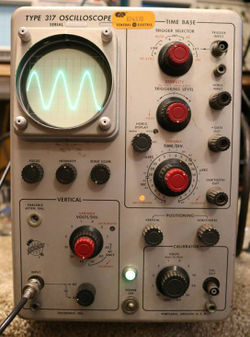317: Difference between revisions
Jump to navigation
Jump to search
No edit summary |
No edit summary |
||
| Line 10: | Line 10: | ||
* [http://bama.edebris.com/manuals/tek/317/ Tektronix 317 Manual (DJVU, BAMA, offline?)] | * [http://bama.edebris.com/manuals/tek/317/ Tektronix 317 Manual (DJVU, BAMA, offline?)] | ||
* [http://w140.com/tek_fcp/tek_type_317_factory_cal_proc.pdf Tektronix 317 Factory Calibration Procedure (PDF)] | * [http://w140.com/tek_fcp/tek_type_317_factory_cal_proc.pdf Tektronix 317 Factory Calibration Procedure (PDF)] | ||
* [[Media:tek_317_fcp.pdf|Tektronix 317 Factory Calibration Procedure (PDF, OCR)]] | * [[Media:tek_317_fcp.pdf|Tektronix 317 Factory Calibration Procedure (PDF, OCR)]] | ||
* [http://w140.com/tek_317_irb.pdf Tektronix 317 Instrument Reference Book (PDF, OCR)] | |||
}} | }} | ||
The '''Tektronix 317''', [[introduced in 1959]], is similar to the [[316]], | The '''Tektronix 317''', [[introduced in 1959]], is similar to the [[316]], | ||
Revision as of 11:37, 13 October 2018
The Tektronix 317, introduced in 1959, is similar to the 316, but with higher acceleration voltage (9 kV versus 1.8 kV) on the CRT. It was intended for use where a bright display is needed. The 317 initially used UHF connectors for the signal input and calibrator output; later units use BNC connectors.
There is also a rackmount version, the RM17.
Type 317 Mod 101 operates on 50 to 400 Hz power and uses a DC fan motor.
Key Specifications
| Deflection | 0.1 V/div to 50 V/div, 1−2−5; 50/20/10 mV/div AC only; variable |
|---|---|
| Bandwidth | DC to 10 MHz |
| Rise time | 35 ns |
| Input | one channel, 1 MΩ // 38 pF input impedance |
| Sweep | 200 ns/div to 2 s/div,1−2−5, and variable |
| CRT | T317 CRT (154-0346-00), 9 kV acceleration |
Links
Pictures
-
-
-
-
-
-
-
RM17
-
317 with camera mount
-
early 317 with leather handle
-
early 317 with leather handle
-
-
-
-
-
-
-
-
RM17
-
RM17



















